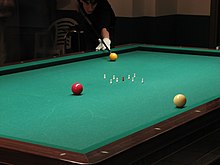Goriziana: Difference between revisions
SMcCandlish (talk | contribs) tweak |
SMcCandlish (talk | contribs) →Goriziana ×2: tweak |
||
| Line 31: | Line 31: | ||
===Goriziana ×2=== |
===Goriziana ×2=== |
||
This variant, also called ''tutti doppi'', is officially recognized by the [http://www.fibis.info/ Italian Federation of Billiard Sport (FIBIS)]. The scores earned in this game are doubled in respect to the normal game. |
This variant, also called '''''tutti doppi''''' ("all-doubled"), is officially recognized by the [http://www.fibis.info/ Italian Federation of Billiard Sport (FIBIS)]. The scores earned in this game are doubled in respect to the normal game. |
||
*''4 points'' for every external pin knocked; |
*''4 points'' for every external pin knocked; |
||
Revision as of 03:07, 15 October 2010
This article may require copy editing for grammar, style, cohesion, tone, or spelling. (October 2010) |
Goriziana or nine-pin billiards (also known as nine-pins, 9-pins, etc.) is a carom billiards game.[1]
Like its closest-related cue sport, five-pin billiards (stecco), it is played on a 284 cm × 142 cm table .
Rules

This billiards game has nine pins in the center of a table. It is played by two teams of 1 or 2 players. Three balls are used of which two are cue balls. Each team (or each player) aims to hit their opponent's ball and from there score points by hitting onto the red ball and also by making the opponent's and/or the red ball knock over the pins.
Unlike in many games, shots are always taken in rotation – the same player or team never shoots twice in a row even if they have scored (other than if the opponent fouled before actually shooting when their turn came up, such as by moving one of the balls accidentally). Play continues until one player or team wins by being the first to achieve or exceed a specific number of points (usually 200 or 300), either agreed upon beforehand by the players.
The main difference between five-pins and nine-pins is the scoring. Accumulated or lost point are doubled in respect to five-pins game.
Scoring and fouls
Scoring:
- 2 points for every external pin knocked;
- 8 points for every internal pin knocked;
- 10 points for knocking red central pin together with one or more white pins;
- 30 points for knocking red central pin only;
- 6 points if after regularly hitting the ball of the opponents, the later hits the red ball;
- 6 points if after regularly hitting the ball of the opponents, the former hits the red ball [2]
In case of a foul 2 points are deducted besides nullify any points the shooter would have earned on the foul shot. Examples of fouls:
- Failure to hit the shooter's own cue ball the right way;
- Failure to hit the opponent's cue ball at all with the shooter's own;
- Knocking over pins with the shooter's own cue ball before hitting the opponent's cue ball;
- Hitting the red ball before hitting the opponent's cue ball.
Variants
This billiards game has been popular mostly in Italy, and among amateur players many variants of the game have emerged, some of which are played in tournaments.
Goriziana ×2
This variant, also called tutti doppi ("all-doubled"), is officially recognized by the Italian Federation of Billiard Sport (FIBIS). The scores earned in this game are doubled in respect to the normal game.
- 4 points for every external pin knocked;
- 16 points for every internal pin knocked;
- 20 points for knocking red central pin together with one or more white pins;
- 60 points for knocking red central pin only;
- 12 points if after regularly hitting the ball of the opponents, the later hits the red ball;
- 12 points if after regularly hitting the ball of the opponents, the former hits the red ball;
- -2 points if failing to hit the opponent's cue ball at all with the shooter's own
Filotto
This variant is the same as goriziana ×2 except for the difference of earning 80 points (instead of 60) if hitting the red pin alone and 80 points can be earned also if five pins are hit in vertical or horizontal line of the so called castle in the middle.
References
- ^ "Pin Billiards Games" at TradGames.org.uk
- ^ Rules FIBIS September 2009
